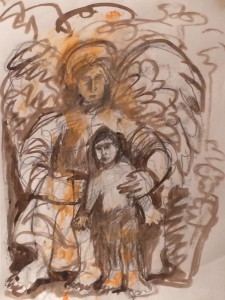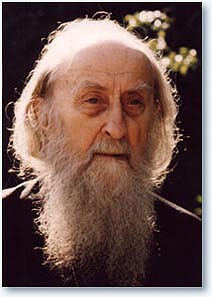The New Guy gave a wonderful homily at church this past Sunday. To set the stage for his words, I’ll tell you that one of the topics I discussed with him in our meeting last week was fasting. I struggle with all the rules that seem so random. Or maybe it’s not the rules but the way they are followed in modern times, when, for example, lobster (shell fish) is okay to eat on fasting days but cheap mac and cheese (dairy) isn’t. I sort of get the whole thing about not eating meat, but it falls apart as I work my way down the list of foods the Orthodox Church guidelines recommend fasting from during certain seasons: meat, meat products, fish, dairy products, oil and wine.
Father Phillip reminded me that it doesn’t have to make sense. That it’s about obedience.
I guess our children, when they are young, don’t understand the rules they are asked to obey either. But they learn something from obedience.

So on Sunday Father Phillip told a story from the book of Tobit (in the Apocrypha.) It’s really a love story about Tobit’s son Tobias and his wife Sarah. But it’s also a cautionary tale. At one point the angel Raphael, who is traveling with Tobias, instructs him to cut open a fish and take the heart, liver and gall and put them in a safe place. How random were those instructions? But Tobias obeyed, and the fish heart, liver and gall came in handy later in the story. The liver and heart were used to cast out a demon, and the gall (bile) was use to cure Tobit’s eight years of blindness.
There’s something about the gall curing blindness that I can’t quit thinking about. Maybe it’s a metaphor for our own spiritual blindness and how obedience—especially to things we might not embrace—can heal us.
Anyway, I’m thinking about these things today as I prepare to attend several talks at a women’s retreat at our church tonight and tomorrow. Our speaker is Dr. Christopher Veniamin, a professor at St. Tikhon’s Orthodox Theological Seminary. His topics are “The Orthodox Understanding of Salvation: ‘Theosis’ in St. Silouan the Athonite and Elder Sophrony of Essex,” and “On Becoming Theologians: ‘Hesychia’ as a Prerequisite for the Encounter with God.”
Born in London, England, Dr. Veniamin is a spiritual child of Elder Sophrony of Essex, who was a spiritual child of St. Silhouan, so he has a strong personal connection to the men he learned the wisdom from—the wisdom that he will be sharing with us.

Archimandrite Sophrony (Sakharov), also known as Elder Sophrony, was best known as the disciple and biographer of St Silouan the Athonite and compiler of St Silouan’s works, and as the founder of the Patriarchal Stavropegic Monastery of St. John the Baptist in Tolleshunt Knights, Maldon, Essex, England. My husband and I visited this monastery in England in 2009, and the nuns and monks there are very devoted to Elder Sophrony’s memory.
A few weeks ago I read this quote in my Orthodox calendar. It’s from Archimandrite Sophrony. I’ll close this post with these words: (an excerpt)
Everything that you gain in your inner battles will be reflected in your life in God. Struggle against every passion which arouses in you critical thoughts about others. Do not accept what the enemy suggests to you against someone who is unjust towards you…. When grace is with us we do not see the defects of others; we only see the sufferings and the love of our brethren.
I can embrace a struggle to love and forgive others.
And in my struggle with fasting, I just read Fr. Stephen Freeman’s (an Orthodox priest in Oak Ridge, Tennessee) latest blog post, “Why We Fast,” which had some helpful information.
But the bottom line is figuring out whether or not I can embrace obedience. Even if I’m asked to cut open a fish and save the heart, liver and gall.
Stay tuned….
The church that was my spiritual home for over twenty years did a major renovation. As part of it, three new windows were made using glass from some of the older windows that had to be removed. They were Eucharistic-themed windows, one each for nourishment, healing, and presence. Interestingly, they all used images from the Hebrew Scriptures and the image of healing included the fish from Tobit.